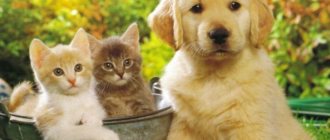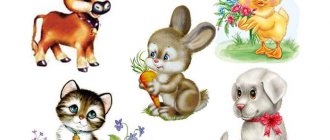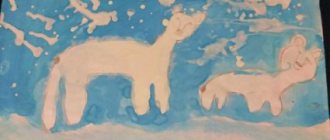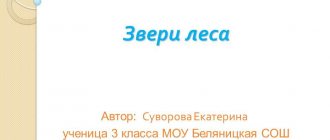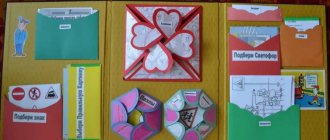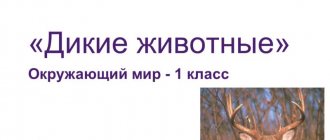MAGAZINE Preschooler.RF
Growing and developing together: interactive games for children 2-4 years old and their parents on the topic “Animals: domestic and wild (forest)”Dear moms and dads!
Let us together help our children grow and develop.
I bring to your attention two games on the topic “Animals: domestic and wild (forest)” for children from 2 to 4 years old.
The first game “Help the animals find their homes” will help your child remember the names of animals, remember the animal’s habitat, and teach them to classify them according to their habitat into domestic and wild (forest).
Rules of the game:
In front of you is a picture divided into two parts: a forest is drawn on the left, and a village on the right. Look carefully at this picture and name who you see in it?
(As a rule, the child will simply begin to list all the animals. Listen to him, and then summarize: they can all be called in one word - animals.)
But every animal has its own home, where it was born and raised. For some animals, the forest became such a home, and for others, the village. Some animals like to live away from people and take care of themselves, while others like to live next to people, they love when people take care of them.
And in our picture the animals got lost and confused their homes. They need help.
Where do you think a dog likes to live? Why? Let's help her and send her home. To do this, you just need to click on the dog.
It is advisable to carry out such preliminary work on each animal, as this will help you understand whether the child understands the differences between domestic animals and wild (forest) animals, and in case of difficulty, help him.
The second game “Wild Animals” consists of a series of games and will help summarize the child’s knowledge on this topic.
The game will help the child remember the names of the main inhabitants of the forest, their habitats (names of their homes), what forest animals like to eat, what their cubs are called, which of the forest inhabitants change their coat color in winter; will teach you to guess riddles about forest animals, based on their characteristic features.
The entire game is divided into five small games.
The first game is “Riddles - guesses” : you read a riddle to your child and ask him to guess it. Ask your child to explain why he thinks this riddle is about this animal. (Each riddle contains the characteristic features of the animal.)
After this, invite your child to click on the blue window with the riddle and check the correctness of his answer.
The second game is “Who eats what” : ask the child to name the pictures that are located at the very bottom - this is food for animals. Now think about which animal likes to feast on what.
What does a squirrel like to eat? Let's check. Click on the picture you named and let's check if the squirrel gets its treat.
Similar work is carried out for each animal.
The third game is “Who lives where?” : Look at the picture with your child, tell him that the houses of forest inhabitants are depicted here. Read the names of these houses to your child and ask him what he thinks which animal lives in which house.
Who lives in a hollow? Let's check: click on the house and check your answer.
The fourth game is “Whose children?” : name the pictures that are drawn below - these are baby forest animals. Let's call them together correctly again: little squirrel, little hare, little hedgehog, little bear, little fox, little wolf. Each baby has its own mother. I will name the animal’s mother for you, and you will name her baby.
The bear has - ... Let's check your answer. Click on the baby and if your answer is correct, he will run to his mother.
Similar work is carried out for each animal.
Fifth game - “Which of these animals changes their coat for the winter? What color?
All animals are preparing for winter: some, like the bear and the hedgehog, fall asleep, others' fur coats become thicker and thicker, and others generally change the color of their coats.
- Part. Look carefully at the forest animals. There is an asterisk next to each of them. You must name the animals that, in your opinion, change the color of their fur coat for the winter, and click on them with the mouse. If your answer is correct, the star will change its color to green and a happy smiley will appear, and if you are wrong, the star will turn red and a thinking smiley will appear.
- Part. You correctly found out which of the forest inhabitants changes the color of their fur coat for the winter. Now let's decide what color it will be.
Look at the colors on the right. Try to name them. If you find it difficult, I will help you.
What color does a squirrel's coat become in winter? Click on the color you named. If your answer is correct, a squirrel in a winter coat and a happy smiley will appear.
If you make a mistake, a thinking emoticon will appear.
We also work with the bunny.
Don't forget to praise your baby at the end.
You can return to these games more than once, giving your baby more independence each time.
| Next > |
Presentation for kindergarten “Pets” – Presentations for kindergarten
Annotation:
The development corresponds to the program of M. A. Vasilyeva. The lesson is complex, it includes the development of speech and familiarization with the environment, they are connected by one plot.
Dynamic pauses based on musical and physical education, the “Fun Training” exercise, breathing exercises, and aromatherapy prevent the child from getting distracted and help move from a difficult task to an easier one. Children consolidate their acquired knowledge and learn to express their impressions and attitudes towards the environment in coherent statements. The presentation consists of 10 slides and has the necessary illustrations.
The summary provides detailed navigation through the presentation slides.
Target audience: for preschoolers
I hope that my recommendations will not offend you, but will give you food for thought and improvement of the presentation. 1. Slide 2. A blurry, unclear picture is poorly perceived, especially for children. It's better to spend a little time and find a clearer picture.
It’s possible that the template seems good to you, it’s green, but on slides 2, 3... it’s superfluous and distracts attention. Therefore, it is better to stretch the picture (proportionally) across the entire slide.
2. Slide 5. The picture needs to be selected without a background inscription and preferably with a saucer (with milk), then the real saucer will not differ so sharply from the drawn kitten. 3. Slide 6. The slide is overloaded with unnecessary and distracting elements - a white frame and a background pattern.
The frame needs to be cut off and the background covered with a picture. 4. Slide 8. It will be more correct if the entire presentation is framed either only with real photographs or hand-drawn pictures. As a rule, pictures in a presentation should be in the same key.
5. Slide 9. It’s great that you know how to use animation tools, but several views on one slide are unnecessary. Animation should be kept to a minimum, because... it distracts attention from the main thing. Unfortunately, I did not see any methodological recommendations for the presentation.
I couldn’t understand how reasonable it was for you to place pictures of animals on one slide. If the lesson plan is just an introduction, it is better to place them on different slides; if there is a comparison, then, of course, on one. Text on slides.
I understand that the children for whom this presentation is made cannot read. Therefore, the text is intended for the teacher as a hint. Then you need to make it less noticeable for children - smaller font and place it at the bottom of the slide.
6. Slide 10. You, of course, have final words to complete the lesson, so it is better to remove the text from the slide (if the children cannot read), or reduce it to one sentence. Sincerely, Natalia.
Summary of a lesson on the surrounding world for preschoolers on the topic “Pets.”
"Visiting Avdotya's grandmother." Goal:
identifying, enriching and consolidating children’s knowledge about domestic animals.
Objectives:
- systematize children’s knowledge about domestic animals.
— expand and deepen children’s knowledge about pets. - cultivate a love for pets. - develop attention and thinking. - induce emotional pleasure in children from activities in the classroom. Preparation for the lesson:
selection of illustrations and musical accompaniment.
Progress of the lesson:
(A recording of animal voices sounds)
Teacher:
Children, what are these sounds?
Children:
Animal voices.
Teacher:
Guys, listen carefully and tell me how in one word you can name the animals whose voices you heard.
Children:
At home.
Teacher:
Why were they called that?
(Children's answers) Teacher:
That's right, these animals live next to humans.
We look after them, feed them. Teacher: What animals live in your home? How do you care for them? (children's answers) Teacher:
- Guys, today we are going on a trip again.
Teacher:
You will find out what we will go on by guessing the riddle.
What a miracle - a long house! There are a lot of passengers in it. Wears rubber shoes and eats gasoline. (Bus) Teacher:
Guys, we will go to the village on the bus and find out what animals can be seen there.
(The song “We are sitting on the bus” plays; the children perform movements to the music) Teacher:
Here we are in the village.
(Grandmother enters) Grandmother Avdotya:
Hello, guys, I’m glad to see you visiting me.
Teacher: Hello, grandma, let's get acquainted! We are the guys from the Know-It-All school. What is your name? Grandma Avdotya:
My name is Grandma Avdotya!
Teacher:
Grandma, we came to you with the guys for a reason, we want to find out if animals live in your village?
Grandma Avdotya:
Of course, the kids live, I’ll be happy to show them to you.
(Images of animals appear on the screen.) Grandma Avdotya:
Here is our cat Murka, she is very affectionate.
Guys, what do you know about cats? What are baby cats called?
Children:
Kittens.
Grandmother Avdotya:
Children, how many of you know what a cat eats?
Grandmother Avdotya:
And here comes Zhuchka.
What are baby dogs called? Children:
Puppies.
Grandmother Avdotya:
The bug lives in a kennel.
She is a very loyal dog and a wonderful watchdog. Grandmother Avdotya:
Our Zorka lives in the barn.
It gives delicious milk, meat, sour cream, cottage cheese, kefir. In summer he likes to eat fresh grass, and in winter he eats hay. Grandmother Avdotya:
A horse lives in the stable, we feed it oats and hay, and it helps us transport heavy loads.
Grandmother Avdotya:
A pig lives in a pigsty.
There she lives with her children - piglets. Pigs eat leftover food, fruits and berries. From them we get meat, lard, and skin. Grandmother Avdotya:
Rabbits and their babies - rabbits - live in cages.
Rabbits love grass, stalks, and tops. In summer they eat hay, branches and carrots. Rabbits give us fur and meat. Grandmother Avdotya:
These are the pens where goats live.
They give us meat, wool, milk. Goats love to eat tree bark and young leaves. Grandmother Avdotya:
Chickens and roosters live in the chicken coop.
Chickens give us eggs, meat and fluff. And the cockerel is our best “alarm clock”; every morning he wakes us up with his crowing. Grandmother Avdotya:
We also have ducks, turkeys and geese, they give us meat and valuable down.
Teacher:
Guys, grandma Avdotya told us about her pets.
So what benefits do these animals bring? (Children's answers) Grandma Avdotya:
How attentive you guys are.
We listened to my story about my favorites for a long time, we’re tired, maybe let’s take a rest. Physical education minute.
An adaptation of
M. Stepanov’s poem “Cat”
Carefully, like a cat, to the sofa from the window I will walk on my tiptoes, lie down and curl myself into a ring.
And now it’s time to wake up, straighten up, and stretch. I can easily jump off the sofa, I will arch my back. And now I’m sneaking around like a cat, I’ll bend my back a little. I lap up the milk from the saucer with my tongue. I will wash my chest and tummy with my paw like a cat. And again I’ll curl up in a ring, like a cat near a warm stove. (the teacher invites the children to play) The game “Who is screaming?”
Cat - "meow-meow" Dog - "woof-woof" Cow - "moo-moo" Pig - "oink-oink" Horse - "yoke-go" Chicken - "co-co-co" Duck - "quack-quack" »
Sketch “Animal Dispute”
(Children show a skit.) Once a cat, a pig, a dog, a cow, a goat, and a chicken argued.
The cat meowed:
“I’m the most important, I catch mice in the house!”
The cow mumbled:
“No, I’m the most important - I give meat, delicious milk, from which sour cream, cottage cheese and other healthy dairy products are made.”
The dog barked:
“I guard the house - I’m the most important!”
The goat remarked:
“No, no, no, I’m the most important - I give wool and warm fluff from which you can knit things!”
The hen clucked
: “You shouldn’t argue, I’m the most important and necessary - I lay eggs!”
The ducklings quacked:
“You can make a soft feather bed from our feathers, so we are in charge!”
Guys, who is right in the argument? Who is more important and needed? Children's answers. Grandmother Avdotya:
You shouldn’t have started an argument, my beloved ones, you are all equally important!
After all, you bring great benefit to people, and we look after you for it! The animals were happy. And they started dancing! Dance of little ducks. Game "Who are the parents?" Teacher:
Children, people have a father and a mother, but what are the parents of animals called?
In kittens - (cat and tom). In chickens - (hen and rooster). In calves - (cow and bull). In piglets - (pig and boar). In lambs - (ewe and ram). In rabbits - (female rabbit and rabbit). In puppies - (dog and dog). In goats - (goat and goat). In foals - (horse and horse). In ducklings - (duck and drake). Teacher:
Since ancient times, domestic animals have lived next to a person’s home; they absolutely cannot do without his help.
They cannot independently obtain food for themselves, escape from enemies, or build a home for themselves. A person takes care of them: builds them warm housing (stables, pigsties, chicken coops, etc.); feeds them; looks after them. And the animals, in turn, thank us and give us many useful things: milk, eggs, wool, meat, fluff, etc. Teacher:
Thank you, Grandma Avdotya.
How much you told us today about pets. We are very glad that we visited you. Grandmother Avdotya:
I was pleased to see you in my village.
All the kids are so smart, attentive, and friendly. My favorite Zorka gave you some delicious milk. Come visit us again. Goodbye! Teacher:
Guys, did you enjoy visiting grandma Avdotya in the village?
Teacher:
What did you like most?
Teacher:
What new have you learned?
(The teacher suggests viewing the presentation and guessing riddles about pets.) Presentation. Teacher:
Children, you did a great job in class. Well done! Thank you!
Olga Volchenkova
Presentation for preschoolers “Pets”
Presentation for preschoolers "Pets"
Slide COW
Cow
- a large horned animal.
Cows
graze in the meadows in summer and eat lush grass.
They give tasty and healthy milk.
It is used to make cottage cheese, yogurt and cream.
Cows
moo. They make a long, loud sound “Moo-oo.” This means that they are hungry, or they are calling the baby, or it is time for milking.
In winter, they eat hay prepared for them.
Slide PIG
Pig
– a very smart pet.
In pigs
poor vision and acute hearing.
Piglets are very active from birth, they have pink heels and curled tails.
For the pigs
They are easy to care for because they quickly become accustomed to a daily routine.
Slide GOAT
Goat
the most unpretentious pet.
The body of goats is covered with long, straight hair, and almost all goats grow a beard.
Goat
milk is very healthy and nutritious.
Goats and kids
are not afraid of heat and frost.
Slide HORSE
Horse
– a very beautiful pet, a person’s favorite and helper.
Horses
They eat oats and hay. They love carrots, apples, crackers and sugar cubes.
Horses
They run fast, and to prevent their hooves from wearing out, people shoe them.
Slide DUCK
Duck
is a waterfowl. She is a distant relative of the wild mallard duck.
duck wings
large, well developed with a wide scope. The short tail is raised upward. The legs are strong, short, and the beak is large.
Ducks with ducklings in winter
live in warm poultry houses.
Slide GOOSE
Goose
larger than a duck, and has longer legs and neck. These birds are amazing because they swim, run and fly equally well.
Usually geese
cackling and talking to each other. And if they don’t like something, they begin to hiss and may even pinch.
Slide CHICKEN
Chicken
- The most common poultry. She gives a person tasty and healthy eggs
In chickens
there is a comb and a beard that help them maintain the body temperature they need.
Cockerels have larger combs than hens, a long bushy tail, and spurs on their legs.
Hens, roosters and chicks
eat grain.
Slide RABBIT
Rabbit
- a very cute and affectionate domestic animal, similar to a hare.
The rabbit differs from the hare in having shorter ears and paws.
Rabbits
need to be fed every day with fragrant hay from mown field grasses.
You also need to give branches of fruit trees or willow, linden, maple so that he can gnaw on them, grinding down his teeth.
Slide CAT
Cats
man's most beloved pets. Baby cats - kittens - are always very playful.
Cat
clean, washes often.
Cat
walks calmly in the dark. These whiskers help her with this.
The cat is walking
silently, retracts its claws and steps with soft pads, climbs trees deftly
Slide DOG
Dog
man's most devoted and faithful friend.
When she meets her owner, she happily wags her tail and barks.
Sometimes dogs
can “sing” – howling to the melody they like.
To the dog
She was smart and obedient, she is being trained: she is taught to carry out various commands.
FISH slide
Pet fish
live in aquariums.
These wonderful pets delight people with their colorful colors.
Types of aquarium fish
a lot: goldfish, angelfish, guppies, barbs and many others.
